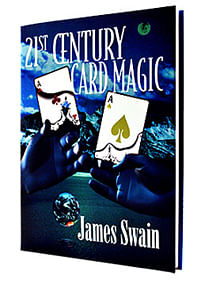21st Century Card Magic by James Swain
Reviewed by Jamy Ian Swiss (originally published in Genii November, 1999)

If you read my rave review of Jim Swain's second book, Miracles With Cards (January 1997 Genii), you'll know that I am an unabashed fan of the kind of card work Mr. Swain tends to publish. A close colleague of some of the best minds in contemporary card magic—notably Darwin Ortiz and Bill Malone, along with Paul Cummins, who is gradually making something of a name for himself in close-up sleight-of-hand circles as well—as a group these men tend to hold their taste in effects and construction to high standards of impact, clarity, and sound construction. This is card magic of a high order.
The book opens with a version of Earl Nelson's "Between Your Points of Departure" from his unfortunately out-of-print book, Variations, which in turn was a combination of two excellent tricks of Alex Elmsley's, "Between Your Palms" and "Point of Departure." I think that Mr. Swain has hit upon the definitively superior version extant—if you want to open the book and instantly learn a fabulous trick, start here! This is followed (both in the book and, as described, potentially in performance) with an entertaining routine, which is a variation of an unpublished Mike Close routine, in which two cards are selected, and then after a funny series of convincing shuffles, the deck returns to new-deck order with the sole exception of the two selections, which have changed places.
Fans of the memorized deck (the author primarily uses the Si Stebbins system) will find a number of interesting effects here, including a terrific three-card location that uses an exquisitely efficient pumping system based on some original work of Bob Farmer's, and a concept the author dubs the Miracle Deck, which is an excellent tool for anyone who is comfortable with both memorized decks and the Pass.
Items contributed by others include the finest version of "Spectator Cuts to the Aces" of which I am aware, courtesy of Bill Malone (who also contributes the book's introduction) —this is the solution that the real workers have been waiting for (and keep in mind that you can use this with Dave Solomon's outstanding "Cutting Ten" presentation from last year's Solomon's Mind). Variations of the work of others include a finessed handling of Paul Cummins' "Count On It" routine, currently popular among cardicians and for good reason; a streamlined handling of a lovely Jennings trick I always liked, "Instant Aces," in which the four Aces are inserted in the deck and instantly reverse themselves; and a Swain handling of Daryl's "Diamond Bar" accompanied by a presentation of Bill Malone's—essentially the adaptation of an old joke, which demonstrates the true-to-life point that weak friends are always more dangerous than strong enemies—that delivers one of the most commercial assembly tricks ever—um—assembled!
Four sophisticated tabled gambling routines include an excellent pseudo-center deal demo, which concludes with a very magical looking pseudo-muck, an eight-card, two-hand riffle stack, and a Magician vs. Gambler plot in which four hands are dealt and the magician's hand, consisting of four indifferent cards, magically transforms into the four Aces (this routine, along with a version of the three-card mental location already mentioned, first appeared in the pages of this magazine).
The book concludes with the author's version of Larry Jennings Chop Cup routine, first published in Genii in 1965, and little known today. The original routine deserves wider notice, and the author's variation is a four-and-a-half minute, surprise filled romp, complete with a three-beat finish. Interest in the Chop Cup is bound to be renewed with the imminent publication of the Don Alan book, and while Alan's 99-second whirlwind is the standard in more ways than one, his dismissive attitude toward the Jennings routine—not to mention Ron Wilson's superb version, which utilized some of the same elements—is belied by the model provided here.
The book is cleanly written and edited, well designed—actually an improvement in this area over Miracles With Cards—and illustrated with the same superbly reproduced photographs of that volume. All in all, another fine batch of powerful material from Jim Swain, and a sound investment for any card-carrying magician.
